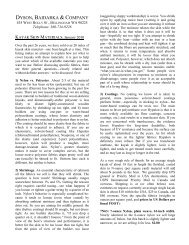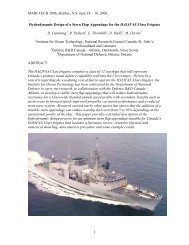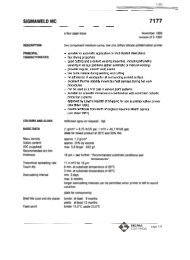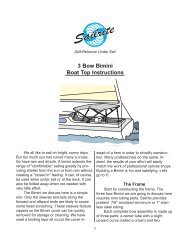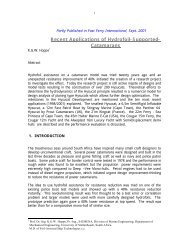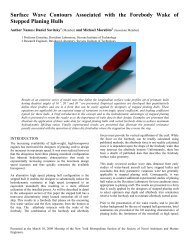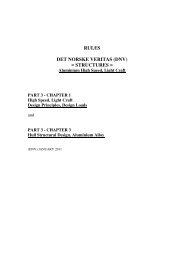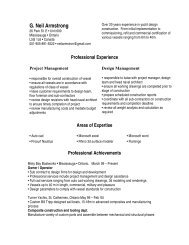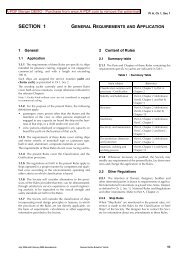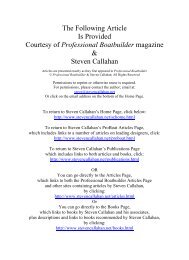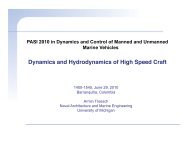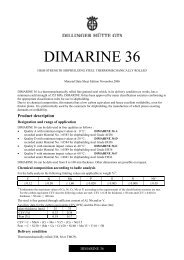Rules for the Classification of Floating Docks - Boat Design Net
Rules for the Classification of Floating Docks - Boat Design Net
Rules for the Classification of Floating Docks - Boat Design Net
You also want an ePaper? Increase the reach of your titles
YUMPU automatically turns print PDFs into web optimized ePapers that Google loves.
Chapter 4Table 7 : Table 7 : Grades <strong>of</strong> steel to be used <strong>for</strong> elements contributing to longitudinal strength, not includedamong those considered in Tab 2, but <strong>of</strong> particular local importanceThickness s ≤ 30 mm 30 < s ≤ 40 mm s > 40 mmNormal strength A and B B EHigher strength steels AH AH DHTable 8Lifting capacity ≤ 40000 t 50000 t 60000 t 70000 t 80000 t 90000 t 100000 tCoefficient C 0,8 0,85 0,89 0,92 0,95 0,97 0,993.2 <strong>Docks</strong> in rein<strong>for</strong>ced concrete or in prestressedrein<strong>for</strong>ced concrete3.2.1 <strong>Docks</strong> in rein<strong>for</strong>ced concrete or in pre-stressed rein<strong>for</strong>cedconcrete are considered by RINA on a case-by-casebasis.4 General requirements <strong>for</strong> scantlings4.1 General4.1.1 The scantlings <strong>of</strong> <strong>the</strong> dock are to be such that <strong>the</strong>indicative values <strong>of</strong> <strong>the</strong> state <strong>of</strong> <strong>the</strong> structure obtained byapplying <strong>the</strong> requirements <strong>for</strong> <strong>the</strong> check <strong>of</strong> <strong>the</strong> longitudinal,transverse and local strength given in <strong>the</strong> following itemsare no greater than <strong>the</strong> values <strong>of</strong> <strong>the</strong> allowable state.The scantlings <strong>of</strong> docks in rein<strong>for</strong>ced concrete or in prestressedrein<strong>for</strong>ced concrete are considered by RINA on acase-by-case basis.States exceeding <strong>the</strong> allowable state, but not in excess <strong>of</strong><strong>the</strong> limit state, may be permitted at RINA's discretion underparticular exceptional circumstances.4.2 Allowable state and limit state4.2.1 Definitionsa) Allowable state: <strong>the</strong> whole <strong>of</strong> <strong>the</strong> allowable stresses andglobal and local de<strong>for</strong>mations.b) Limit state: <strong>the</strong> whole <strong>of</strong> <strong>the</strong> stresses and global andlocal de<strong>for</strong>mations beyond which <strong>the</strong> structure loses itsfunctional characteristics.c) State <strong>of</strong> <strong>the</strong> structure: <strong>the</strong> whole <strong>of</strong> <strong>the</strong> stresses and globaland local de<strong>for</strong>mations <strong>of</strong> <strong>the</strong> structure.The allowable state and limit state are defined with referenceto <strong>the</strong> mechanical characteristics <strong>of</strong> materials and <strong>the</strong>stability conditions <strong>of</strong> elastic equilibrium <strong>of</strong> <strong>the</strong> structure.4.2.2 Steel docksa) Allowable stresses:σ id amm = 160/K, in N/mm 2τ am = 90/K, in N/mm 2The values <strong>of</strong> <strong>the</strong> coefficient K are those indicated inPart B <strong>of</strong> <strong>the</strong> <strong>Rules</strong>, in respect <strong>of</strong> <strong>the</strong> steel grade.b) Limit stresses:σ id lim = 0,9 σ snτ am = 0,52 σ snwhere σ sn is <strong>the</strong> nominal yielding stress <strong>of</strong> <strong>the</strong> material.Stress values less than those indicated in items a) and b)may be assumed, at RINA's discretion, with respect to <strong>the</strong>requirement <strong>of</strong> granting adequate safety <strong>for</strong> possible instabilityphenomena.4.3 Direct calculations4.3.1 When checking <strong>the</strong> constructional drawings, RINAmay consider material distribution and scantlings o<strong>the</strong>r thanthose obtained applying <strong>the</strong> requirements <strong>for</strong> <strong>the</strong> check <strong>of</strong>longitudinal, transversal and local strength given in <strong>the</strong> followingitems, provided that it is demonstrated, by means <strong>of</strong>direct calculations based on <strong>the</strong>oretical assumptions and/orexperimental results, that <strong>the</strong> allowable state or, <strong>for</strong> exceptionalload conditions, <strong>the</strong> limit state is not exceeded.Direct calculations made in accordance with <strong>the</strong> mostadvanced techniques are to be carried out wheneverrequested by RINA and in general in <strong>the</strong> case <strong>of</strong> unusualstructures or docks <strong>of</strong> large dimensions or particular characteristics.RINA reserves <strong>the</strong> right to require structural checks, alsotaking into account particular conditions which may exceptionallyoccur during <strong>the</strong> dock operation.The direct calculations are to be carried out <strong>for</strong> <strong>the</strong> mostsevere anticipated realistic load conditions.In particular, if <strong>the</strong> hydrostatic loads on <strong>the</strong> local structuresare determined with respect to <strong>the</strong> differential heads anticipatedduring operation and it is possible that, due to damage,said heads may be exceeded, <strong>the</strong> check with <strong>the</strong> loadcondition due to <strong>the</strong> extreme hydrostatic head which maybe assumed on <strong>the</strong> structure is to be carried out.4.4 Longitudinal strength4.4.1 Load conditionThe longitudinal strength is to be verified <strong>for</strong> dock operativeconditions, with <strong>the</strong> waterline corresponding to <strong>the</strong> pontoonfreeboard B le , with a structure with load equal to <strong>the</strong>design lifting capacity <strong>of</strong> <strong>the</strong> dock arranged on <strong>the</strong> floorand, as far as practicable, symmetrically on length.In <strong>the</strong> absence <strong>of</strong> more precise data, <strong>the</strong> conventional distribution<strong>of</strong> ship loads shown in Fig 2 may be assumed <strong>for</strong> drydocks.18 <strong>Rules</strong> <strong>for</strong> floating docks 2010



